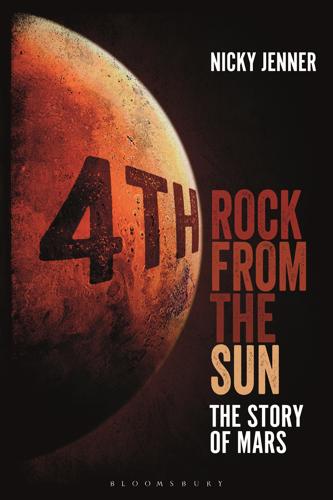
4th Rock From the Sun: The Story of Mars
by
Nicky Jenner
Published 5 Apr 2017
It bonds to itself more weakly than carbon does, is more reactive, and would be unable to use water as a solvent, so there’d need to be another present (methane would work, but any environment would thus require both abundant silicon and methane). It’s possible that extraterrestrial life could be silicon-based, but it wouldn’t be a case of simply replacing the carbon within us with silicon. Silicon-based life would be truly alien: the entire structure and system of life would need to be reimagined to suit the properties and chemistry of the silicon atom. We also look for ‘out-of-equilibrium’ gases as possible markers of life. These are gases that would usually naturally degrade or combine to form another substance, but exist in a planet’s atmosphere in higher-than-expected levels because they are regularly replenished by some ongoing process occurring on the planet.
…
here–here, here Mars Climate Observer (MCO) here–here Mars Express here, here, here, here, here–here Mars Global Surveyor (MGS) here, here, here, here–here, here Mars Hope here Mars Observer here–here Mars Odyssey here, here Mars One here, here–here Mars Orbiter Laser Altimeter (MOLA) here–here Mars Orbiter Mission (MOM) here–here Mars Polar Lander (MPL) here–here Mars Reconnaissance Orbiter (MRO) here–here, here, here Mars Science Laboratory (MSL) here, here–here, here Marshall-Green, Logan here Martian, The here–here, here, here, here–here, here, here, here, here Massachusetts Institute of Technology (MIT) here Massimino, Mike here MAVEN (Mars Atmosphere and Volatile Evolution) here–here, here McKay, Chris here McKay, David here, here Méndez, Arnaldo Tamayo here Mercury here, here, here, here astrology here orbit here meteorites here–here microgravity here, here human body here–here mental health here personality here–here social health here–here Molenaar, Gregory here, here Moon here, here, here, here, here, here, here first crash landing here first manned landing here first soft landing here Mars here Moon landings here, here, here–here, here, here musicians here–here Musk, Elon here, here, here, here, here–here Mustard, John here mythology here, here–here Mars in other cultures here–here Naderi, Firouz here NASA here–here, here, here, here, here, here–here, here, here–here, here, here astronauts’ radiation exposure here benefits of research here–here Human Research Program here manned missions to Mars here–here The Martian here–here National Centre for Space Studies (CNES), France here Navarro-González, Rafael here Neptune here astrology here–here Noachian Period here–here Nozomi here–here Nye, Bill here Obama, Barack here–here oceans here–here Olympus Mons here, here, here, here, here Opportunity here, here, here, here, here–here, here, here, here orbit of Mars here–here Orion here, here Outer Space Treaty 1967 here Páez, Leonardo here–here palmistry here–here panspermia here, here pareidolia here–here Pathfinder here, here–here Petranek, Stephen here Pettit, Don here Phobos here–here, here, here–here death of Phobos here–here discovery here, here–here, here, here formation here–here mythology here–here Phobos (Fobos) 1 and 2 here, here Phobos-Grunt here, here Phoenix here, here, here Picus here Pierre Guzman Prize here–here planetary embryos here–here, here planetesimals here, here, here, here, here–here, here Plato here, here Plutarch here–here Pluto here astrology here–here discovery here, here poles here pressure here–here private missions here–here Prometheus here Protazanov, Yakov here Ptolemy here–here, here, here radiation here, here–here, here recurring slope lineae (RSL) here, here, here, here, here red cultural significance here–here, here–here natural world here psychosocial significance here Red Dragon here Red Planet here, here–here, here Rees, Martin here, here retrograde motion here–here, here Rheticus here–here Richer, Jean here RNA here–here Robinson, Kim Stanley Mars trilogy here, here–here, here robots here–here Curiosity here–here Martian yellow storm of 1971 here–here robots of the future here–here rovers here–here Roche, Joseph here–here Romulus and Remus here Roscosmos here, here, here, here, here–here Rosetta here–here RTGs (radioisotope thermoelectric generators) here Ryumin, Valery here Sagan, Carl here, here, here Cosmos here–here, here, here Salisbury, Frank here–here Salyut 1 here Santa Claus Conquers the Martians here Saturn here, here, here, here astrology here Schiaparelli here–here Schiaparelli, Giovanni here, here, here, here, here, here Schulze-Makuch, Dirk here Schwarzenegger, Arnold here science here–here science fiction here, here–here, here canals on Mars here–here comics here–here films here–here television here–here video games here–here Scott, Ridley here, here Shepard, Alan here Shklovsky, Iosif here silicon-based life here–here Sinton, William here, here Skylab 4 here soil here, here–here Sojourner here–here, here, here, here Solar System here, here, here, here, here, here, here, here, here Aristotelian astronomy here formation here–here Ptolemaic astronomy here–here, here, here Soviet space programme here–here, here, here–here, here, here–here, here space here first spacewalk here life from space here–here missions to Mars here space exploration here–here, here Space Launch System (SLS) here, here–here, here Space Race here robots on Mars here–here US here, here–here USSR here–here SpaceX here, here, here, here, here–here Special Regions here–here Sphinx-99 here–here Spirit here, here, here–here, here, here, here Sputnik 1 here, here Sputnik 22 here Sputnik 24 here–here, here Sun here, here, here, here–here, here, here–here surface here–here, here surface conditions here–here, here–here Swift, Jonathan Gulliver’s Travels here–here, here, here symbolism here–here Men are from Mars, Women are from Venus here–here Syrtis Major here–here, here tardigrades here tarot cards here–here technology here–here tectonics here, here, here–here, here, here television shows here–here Tereshkova, Valentina here terraforming here–here Tesla Motors here, here Tesla, Nikola here–here Tevis, Walter The Man Who Fell to Earth here Tharsis dome here, here, here, here, here Tholus here Tito, Dennis here Todd, David Peck here Tolstoy, Aleksey Nikolayevich Aelita here Tombaugh, Clyde here, here Total Recall here Tyson, Neil deGrasse here, here United Arab Emirates here Universe here, here–here, here, here Uranus here astrology here Valles Marineris here, here–here, here, here, here Vasavada, Ashwin here, here, here, here–here Vastitas Borealis here vegetation here–here Venera here Venus here, here, here, here, here–here astrology here probes here video games here–here Viking 1 and 2 here, here, here–here, here, here–here, here–here, here, here Virgin Galactic here–here virtual reality here–here volcanism here–here, here–here Von Braun, Wernher here–here, here, here Voyager here Wallace, Alfred Russel here water here, here–here, here hunt for life here–here water bears here Weir, Andy The Martian here–here Welles, Orson here Wells, H.
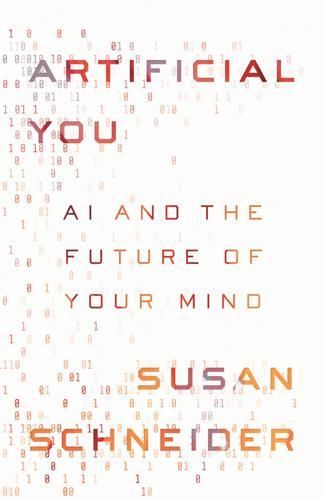
Artificial You: AI and the Future of Your Mind
by
Susan Schneider
Published 1 Oct 2019
At the most demanding level, we might see if the machine invents and uses consciousness-based concepts on its own, without our prompts. Perhaps it is curious about whether we are conscious, even though we are biological. The following example illustrates the general idea. Suppose we find a planet that has a highly sophisticated silicon-based life form (call them the “Zetas”). Scientists observing them begin to ask whether the Zetas are conscious. What would be convincing proof of their consciousness? If the Zetas express curiosity about whether there is an afterlife or ponder whether they are more than just their bodies, it would be reasonable to judge them as conscious.
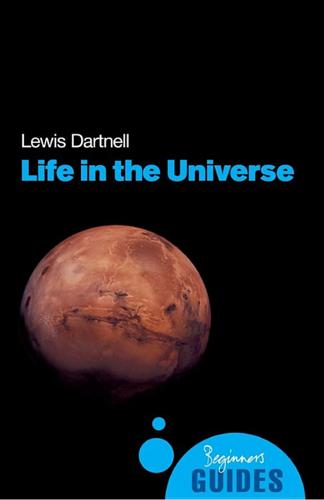
Life in the Universe: A Beginner's Guide
by
Lewis Dartnell
Published 1 Mar 2007
Index accretion disc acetylene acidity acidophiles aerobes aerobic respiration algae ALH84001 alien life alkaliphiles Alpha Centauri amino acids ammonia amono-peptides anaerobes anaerobic respiration Andromeda Galaxy Anomalocaris Antarctic Dry Valleys anthropic principle aquifers artificial life asteroids astrobiology definition astrometry atmosphere of Earth of Mars of Titan ATP ATP synthase autocatalysis autotrophs bacteria barophiles Betelgeuse Big Bang biofilms biosignature/biosign biosphere black smoker see hydrothermal vents blue shift bombardment Callisto (moon of Jupiter) Cambrian Explosion 55 Cancri A carbohydrate carbon isotopes carbonaceous chondrites carbonate-silicate cycle carbon dioxide carbon fixation carbonic acid cell membrane cells cryopreserved chemoautotrophs chemosynthesis chirality (handedness) chitin chlorophyll chloroplasts climate collagen comets complex life continental crust convergence co-rotation cycle cosmic radiation craters cryo-volcanism cryptoendoliths cyanide cyanobacteria cytoplasm Darwinian definition Darwin space telescope Darwin’s pond deep basalt aquifers Deimos (moon of Mars) denaturation Devon Island DNA Doppler effect Earth Earthshine EcoSphere ecosystem enantiomers Enceladus (moon of Saturn) endolithic environments endosymbiosis energy extraction inorganic environment enzymes Epsilon Eri Eridanus eukaryotes Europa (moon of Jupiter) evolution extinction extra-solar planets extremophiles eye fixation carbon methane nitrogen flight formaldehyde formamide fossil record free radicals Gaia galaxies Andromeda Galaxy metallicity Milky Way Galileo Galilei Galileo probe Ganymede (moon of Jupiter) glaciation, runaway glucose Goldilocks Principle Golgi body gravitational microlensing greenhouse effect grylloblattid insects habitable zone haemoglobin halophiles handedness see chirality Haughton Crater HD28185 HD209458b Herschel, William heterotrophs homeobox genes Hot Jupiters Hubble Space Telescope Huygens lander hydrogen hydrogen cyanide hydrosphere hydrothermal vents hyperthermophiles icebugs impact impact frustration inorganic energy interference patterns interferometry Io (moon of Jupiter) iron ferrous isotope jarosite Jupiter moons Kepler spacecraft Krebs cycle life artificial emergence of as energy disequilibrium as information transmission on Mars lithoheterotrophs lithosphere Lowell, Percival LUCA (last universal common ancestor) magnetic fields Mars atmosphere canals environmental collapse evolution of life on geography Hellas impact basin Meridiani Planum Olympus Mons survival of life Valles Marineris volcanoes water on M-class dwarves Mercury Meridiani Planum metabolism metallicity metamorphosis meteorites methane methane fixation methanogens Milky Way mitochondria Moon formation of mRNA multicellular organisms Murchison meteorite myxobacteria natural selection nebulae Neptune nitrogen nitrogen fixation nucleotides nucleus oceanic crust Opportunity Mars Rover organelles organics on Mars synthesis organisms multicellular organoheterotrophs Orion osmosis oxidation oxygen oxygenic processes ozone PAH see polycyclic aromatic hydrocarbons panspermia, permafrost Phobos (moon of Mars) photoautotrophs photosynthesis planetary orbits planet formation plate tectonics Pluto polarity polycyclic aromatic hydrocarbons polymers porphyrins potential difference prebiotic chemistry primordial soup progenote collective prokaryotes proteins protein synthesis protons Proxima Centauri psychrophiles pulsars radial velocity technique red dwarves see M-class dwarves redox redox couples redox potential red shift reduction respiration reverse transcriptase ribose ribosomes ribozymes Rio Tinto RNA RNA world rockcrawlers Rubisco enzyme salinity Saturn moons Schiaparelli, Giovanni sight silicon-based life Sirius SLiMEs Snowball Earth snow line Space Interferometry Mission spallation zone Spirit Mars rover stars birth of Sun-like stromatolites subduction zones subsurface lithotrophic microbial ecosystems see SLiMEs sugars Sun supernovae symbiosis tardigrades (water bears) Tau Bootis Tau Ceti temperature Terrestrial Planet Finder thermophiles threose/TNA tidal heating tidal locking Titan (moon of Saturn) transit method tree of life triple alpha process tRNA ultraviolet (UV) radiation uranium Uranus Urey-Miller reactions vegetation Venus Viking probes viruses volatiles volcanism Vostok, Lake water on Mars phase diagram
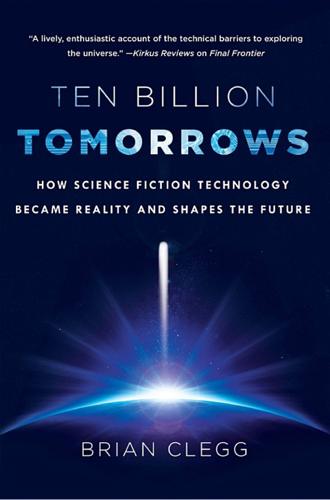
Ten Billion Tomorrows: How Science Fiction Technology Became Reality and Shapes the Future
by
Brian Clegg
Published 8 Dec 2015
So, extremely large aliens would need much chunkier limbs than they are usually portrayed as having. One possible way around this would be if the aliens didn’t have the same composition as us. It is possible to imagine that they could have skeletal structures based on much stronger equivalents of bone, or could be silicon-based life (see here) with a greater ability to withstand the pull of gravity, perhaps needed for a high mass planet. Gravity itself is a variable that needs consideration when we come to aliens. Could an alien life-form develop on planets with a much higher gravitational pull than Earth—probably requiring a totally different approach to movement, as legs would inevitably suffer—or in gravity fields so weak that they could float in the atmosphere like the balloon creatures in Ray Bradbury’s Martian Chronicles?

The Soul of a New Machine
by
Tracy Kidder
Published 1 Jan 1981
Maybe in promoting the metaphorical relationship between people and machines, cybernetics tended to cheapen and corrupt human perceptions of human intelligence. Or perhaps this science promised to advance the intelligence of people as well as of machines and to imbue the species with a new, exciting power. "Silicon-based life would have a lot of advantages over carbon- based life," a young engineer told me once. He said he believed in a time when the machines would "take over." He snapped his fingers and said, "Just like that." He seemed immensely pleased with that thought. To me, though, the prospects for truly intelligent computers looked comfortably dim.
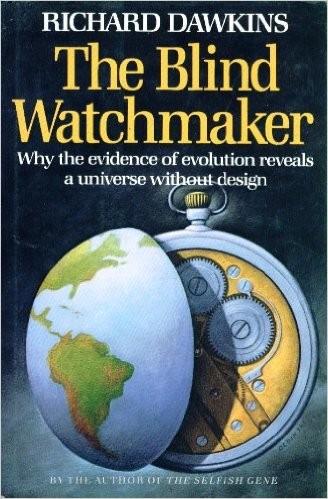
The Blind Watchmaker; Why the Evidence of Evolution Reveals a Universe Without Design
by
Richard Dawkins
Published 1 Jan 1986
Will he go into detail and reconstruct DNA as a plausible early replicator, victim of electronic usurpation? And will he be far-sighted enough to guess that even DNA may itself have been a usurper of yet more remote and primitive replicators, crystals of inorganic silicates? If he is of a poetic turn of mind, will he even see a kind of justice in the eventual return to silicon-based life, with DNA no more than an interlude, albeit one that lasted longer than three aeons? That is science fiction, and it probably sounds far-fetched. That doesn’t matter. Of more immediate moment is that Cairns-Smith’s own theory, and indeed all other theories of the origin of life, may sound far-fetched to you and hard to believe.

What Technology Wants
by
Kevin Kelly
Published 14 Jul 2010
And when silicon is oxidized, its respiratory output is a mineral precipitate, rather than the gaslike carbon dioxide. That makes it hard to dissipate. A silicon creature would exhale gritty grains of sand. Basically, silicon produces dry life. Without a liquid matrix it’s hard to imagine how complex molecules are transported around to interact. Perhaps silicon-based life inhabits a fiery world and the silicates are molten. Or perhaps the matrix is very cold liquid ammonia. But unlike ice, which floats and insulates the unfrozen liquid, frozen ammonia sinks, allowing the oceans to freeze whole. These concerns are not hypothetical but are based on experiments to produce alternatives to carbon-based life.

The Transhumanist Reader
by
Max More
and
Natasha Vita-More
Published 4 Mar 2013
In this process, human presence becomes virtualized and the individual self is distributed, space becomes virtualized and place becomes distributed. Moreover, there is inherent in all the research which currently surrounds the sciences of mind, advanced AI, AL, molecular engineering, robotics, and complex systems, the potential for consciousness to evolve beyond the human organism, and to a degree which perhaps only silicon-based life could accommodate, in “entities as complex as ourselves, and eventually into something transcending everything we know – in whom we can take pride when they refer to themselves as our descendants” (Moravec 1988). Art in the twenty-first century may come to constitute a form of mediation between human and post-human consciousness, just as in past cultures it has been used to mediate between mankind and the gods.